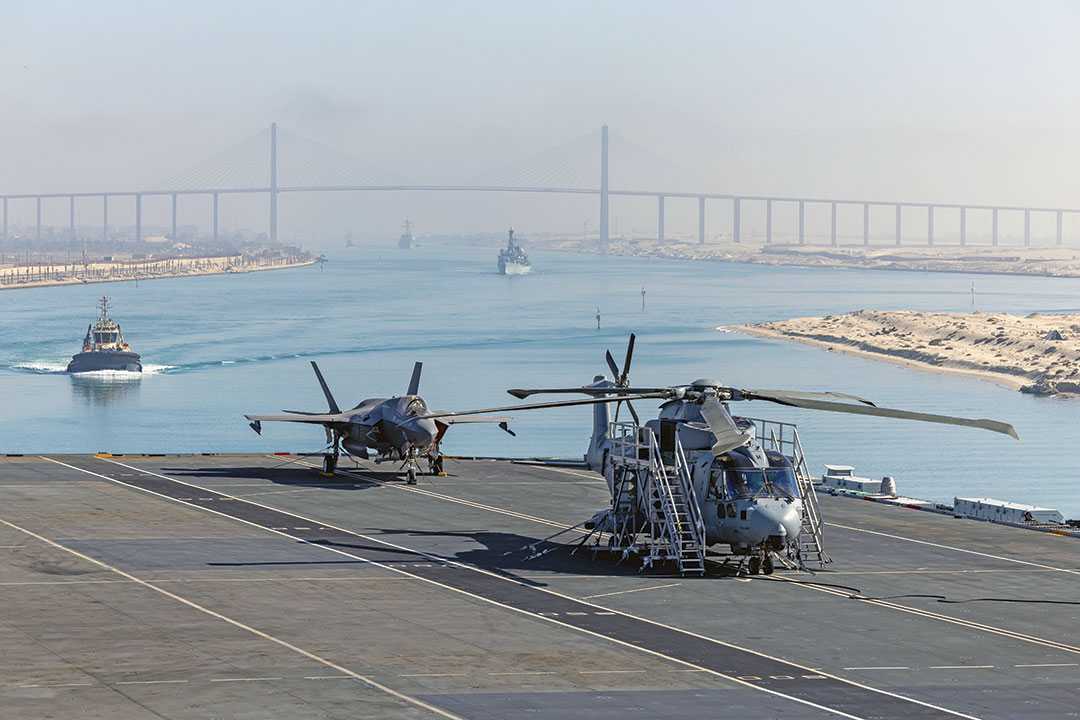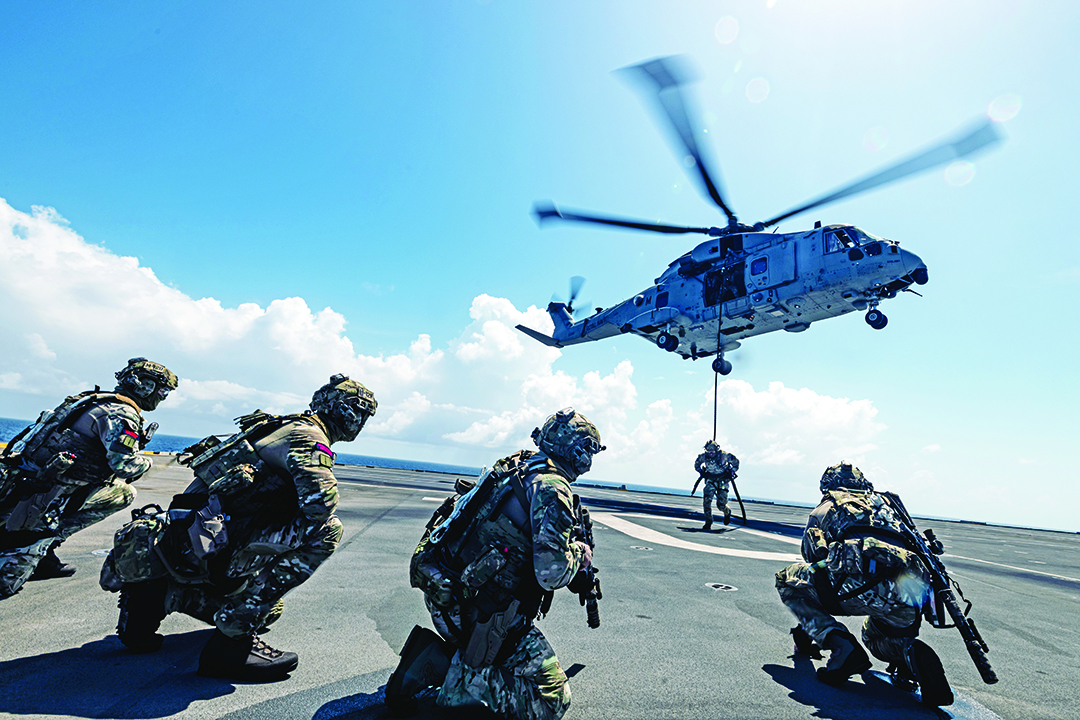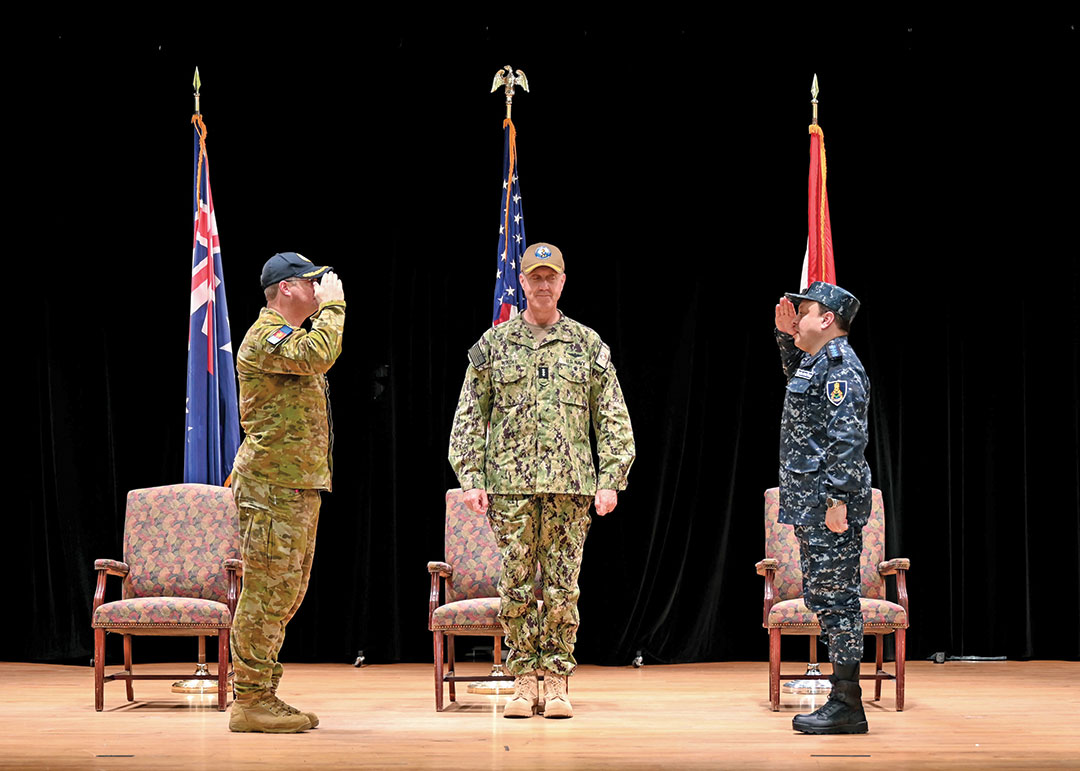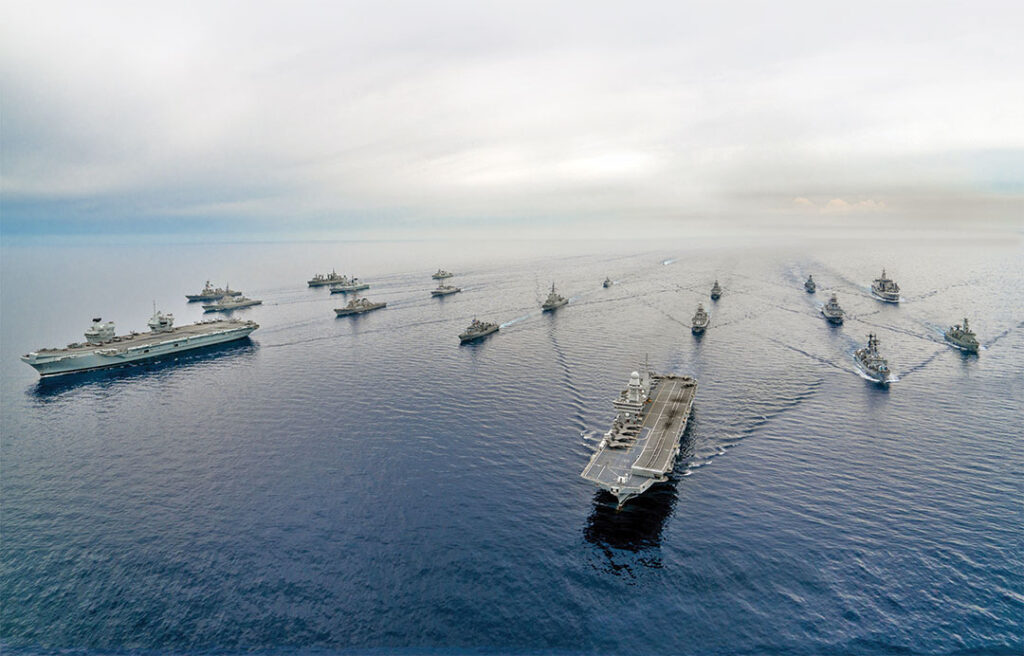The commander of the United Kingdom Carrier Strike Group (CSG), Commodore James Blackmore, sits at the head of a complex, multinational strike group to deliver strategic effect in the Indo-Pacific region. The strike group’s flagship, the aircraft carrier HMS Prince of Wales, embarked from the U.K. The group consists of multinational constituent force elements: U.K. sovereign ships (HMS Dauntless, HMS Richmond, RFA Tidespring) as well as multinational units, including the Spanish frigate SPS Méndez Núñez, Norwegian frigate HNoMS Roald Amundsen and Canadian frigate HMCS Ville De Quebec.
Operation Highmast, as CSG activities are called, met key milestones. In May 2025, the strike group executed Exercise Med Strike, a highly complex NATO training event involving 21 warships, three submarines, 41 fighter aircraft, 19 helicopters, 10 patrol aircraft and more than 8,000 personnel.
During its mission, the strike group transited the Red Sea on its way to the Indo-Pacific. The U.K. CSG was joined by U.S. destroyers USS The Sullivans and USS Truxtun for this element of
the deployment, integrating the CSG into both
U.S. Central Command and Combined Maritime Forces for associated support to Combined Task Force 153, providing Red Sea security under Egyptian command.

Vessels from other nations — 13 in total across the whole of Operation Highmast — joined the CSG as it executed the scheme of maneuver. These nations included Australia, Japan, New Zealand, and the Republic of Korea. Highmast participants also trained with other nations as the group transited through various regions.
Operation Highmast demonstrated that the CSG is truly multinational. The CSG is a convening force for other nations to integrate with, which amplified its strategic effect. This is the very definition of interoperability, in which the strike group can integrate into any command structure and fulfill any mission. This is unique.
To do this is not easy, particularly when it comes to command and control (C2). In fact, it is riddled with complexity. Command and control is difficult enough within a sovereign task group, across mission systems, communication bearers and various tactical data links. But to do this across a multinational force, within a different U.S. military architecture, is hugely more complex.
Interoperability is the ability of different systems, organizations and nations to work together seamlessly and efficiently. In today’s world, multinational partnerships and interoperability are not conveniences but are strategic necessity. Partnerships are force multipliers, and if we are to gain comparative advantage against proliferating threats, we need flexible C2 architecture to integrate various partnerships at any time and at any place to achieve warfighting capability at scale. Within the U.K.’s CSG and in concert with our Partners and Allies, we are harnessing new digital technologies to help achieve this. New information sharing environments, based on a data-centric approach to security rather than through traditional stovepiped networks and systems, are helping to break down old ways of operating.

This new way of working, particularly at the secret releasable level, already is proving its worth. The information sharing environment allows us to enable various digital enclaves to permit the right level of sharing among nations, across email, VOIP, chat and video teleconferencing. The capability is in its infancy, but it will increase throughout the Operation Highmast deployment. It soon will be interoperable with the well-known CENTRIX systems, including Combined Maritime Forces and with Co-operative Maritime Forces Pacific. This will allow information sharing beyond the traditional Five Eyes and NATO levels, enabling nontraditional multinational forces to integrate more easily.
When this is partnered with high bandwidth satellite communication, it is easy to start to see what the future enabling of C2 may look like. This could change the way C2 operates across coalitions of the willing when and if they are needed.
In an increasingly hyperconnected world, the credibility of multinational strike groups is vital. Assuring command and control in this way will allow us to assemble maritime forces at the point of crisis when needed.
Egypt takes lead of Combined Task Force 153
U.S. NAVY
The Egyptian Navy assumed command of the Combined Maritime Forces’ (CMF) Combined Task Force (CTF) 153 from the Royal Australian Navy at a ceremony held in Bahrain in April 2025.
Royal Australian Navy Capt. Jorge McKee handed over command to Egyptian Navy Commodore Mohamed Rasmy at a ceremony presided over by U.S. Navy Vice Adm. George Wikoff, then commander of Combined Maritime Forces.
The task force is responsible for maritime security in the Red Sea and Gulf of Aden. Under McKee’s leadership, the task force, composed of 44 officers from 13 nations, cooperated closely with other CMF task forces, the Joint Maritime Information Center, and the U.S. Navy’s Task Forces 55 and 59 to enhance maritime security in the Red Sea and western Gulf of Aden.
In his remarks, Commodore Rasmy provided a glimpse into the future of maritime security under his leadership of the task force.

“The importance of the sea is the same for all nations, regardless of the size of the Navy they possess,” he said. “The new multidimensional features of maritime security require a new comprehensive and cooperative approach. The culture of information sharing must be advanced within all maritime partners as a cornerstone of integrating our collective efforts with the maritime shipping industry.”
Wikoff commended Rasmy and highlighted Egypt’s long-standing commitment to the CMF.
“The CMF is fortunate to have the tremendous leadership of Egypt once again to lead one of our very important missions,” Wikoff said. “The Arab Republic of Egypt has shown deep, deep commitment to its work, and we in the combined maritime forces are very grateful for your continued leadership.”
Established in April 2022, CTF 153 is one of five task forces under CMF. Its mission is to deter and impede illicit nonstate actors in the Red Sea, Bab el-Mandeb and Gulf of Aden. CTF 153’s area of responsibility includes some of the world’s most important shipping lanes, connecting the Mediterranean Sea with the Indian Ocean and the greater Middle East region.
Combined Maritime Forces, a 46-nation naval partnership headquartered in Bahrain, is the world’s largest multinational naval partnership. It is committed to upholding the rules-based international order at sea, promoting security, stability and prosperity across about 8.3 million square kilometers of international waters, including crucial shipping lanes.
Departing Australian commander McKee acknowledged Wikoff for his leadership of CMF and thanked all CMF task forces, as well as the crews of the aircraft and ships that patrolled for CTF 153.
“In CTF 153, our role has been to shine a light on the unseen — to find those who hide in the shadows and who exploit that darkness for just one reason — because they profit from it,” McKee said.
“We have recently witnessed the consequences of long shadows over the sea. From spikes in shipping costs inflating the price of our daily needs, to the narcotics smuggled across the ocean and into our cities. Uncertainty and insecurity at sea here reaches right into homes across the world.”

